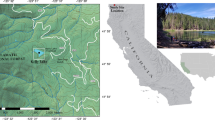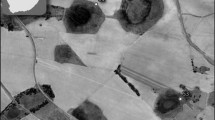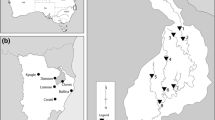Abstract
Mongolia is an arid land with limited freshwater availability. Recent changes in climate as well as changes in livestock management in the post-Soviet era may threaten the quality and availability of these freshwater resources and emphasize the need to characterize current conditions relative to a long-term baseline. Because diatoms are responsive to changes in water chemistry and are commonly preserved in lake sediments, they can be used as indicators of both present and past water quality. To these ends, we have developed a diatom-based calibration set and quantitative inference models for the region. Physical and chemical factors and modern diatom communities were sampled at 54 sites in western Mongolia in the Altai and Khangai mountains and the Valley of the Great Lakes. Canonical correspondence analysis (CCA) demonstrated that both salinity and total phosphorus accounted for statistically significant fractions of the variation in 151 diatom taxa across the 54 sampled sites. Diatom-based inference models were developed with weighted averaging (WA) techniques and showed strong predictive capabilities and low prediction errors for salinity and total phosphorus. These models are now available to help identify and interpret historical and future disturbances to this sensitive and globally important eco-region.






Similar content being viewed by others
References
Ameel JJ, Axler RP, Owen CJ (1993) Persulfate digestion for determination of total nitrogen and phosphorus in low-nutrient waters. American Environmental Laboratory, October 1993, pp 1–11
Anderson NJ (2000) Diatoms, temperature and climatic change. Eur J Phycol 35:307–314
Batbold K, Tuul Z, Oyun B (2004) Access to water and sanitation services in Mongolia: a report to the United Nations Development Programme. Hiimori Printing Company, Ulaanbaatar
Batima P (2006) Climate change vulnerability and adaptation in the livestock sector of Mongolia: AIACC Project Report AS06. International START Secretariat, Washington DC
Bennett EM, Carpenter SR, Caraco NE (2001) Human impact on erodable phosphorous and eutrophication: a global perspective. Bioscience 51:227–234. doi:10.1641/0006-3568(2001)051[0227:HIOEPA]2.0.CO;2
Birks HJB (1990) Diatoms and pH reconstruction. Philos Trans R Soc Lond B Biol Sci 327:263–278. doi:10.1098/rstb.1990.0062
Cumming BF, Wilson SE, Hall RI, Smol JP (1995) Diatoms from British Columbia (Canada) lakes and their relationship to salinity, nutrients, and other limnological variables. Biblioth Diatomol 31:1–207
Dai A, Trenberth KE, Karl TR (1998) Global variations in droughts and wet spells, 1900–1995. Geophys Res Lett 25:3367–3370. doi:10.1029/98GL52511
Dorofeyuk NI, Tarasov PE (1998) Vegetation and lake levels in Northern Mongolia in the last 12,500 years as indicated by data of pollen and diatom analyses. Stratigr Geol Correl 6:70–83
Dulmaa A (1979) Hydrobiological outline of the Mongolian lakes. Int Rev Hydrobiol 64:709–736
Edlund MB, Soninkhishig N, Williams RM, Stoermer EF (2001) Biodiversity of Mongolia: checklist of diatoms, including new distributional reports of 31 taxa. Nova Hedwigia 72:59–90
Fowell SJ, Hansen BCS, Peck JA, Khosbayer P, Ganbold E (2003) Mid to late Holocene climate evolution of the Lake Telmen Basin, North Central Mongolia, based on palynological data. Quat Res 59:353–363. doi:10.1016/S0033-5894(02)00020-0
Fritz SC, Cumming BF, Gasse F, Laird KR (1999) Diatoms as indicators of hydrologic and climatic change in saline lakes. In: Stoermer EF, Smol JP (eds) The diatoms: applications for the environmental and earth sciences. Cambridge University Press, Cambridge 482 pp
Grunert J, Lehmkuhl F, Walther M (2000) Paleoclimatic evolution of the Uvs Nuur basin and adjacent areas (Western Mongolia). Quat Int 65:171–192. doi:10.1016/S1040-6182(99)00043-9
Houghton JT, Ding Y, Griggs DJ, Noguer N, van der Linden PJ, Dai X, Maskell K, Johnson CA (eds) (2001) Climate change 2001: the scientific basis. Cambridge University Press, Cambridge
Juggins S (2003) C2 User guide. Software for ecological and palaeoecological data analysis and visualisation. University of Newcastle, Newcastle upon Tyne, 69 pp
Kelderman P, Batima P (2006) Water quality assessment of rivers in Mongolia. Water Sci Technol 53:111–119. doi:10.2166/wst.2006.304
Krammer K, Lange-Bertalot H (1986–1991) Bacillariophyceae. Susswasserflora von Mitteleuropa. Band 2(1–4). Vols. 1–4 Tiel 1(1986, pp. 876) 2(1988, pp. 596) 3(1991, pp. 576) 4(1991, pp. 437). Gustav Fischer Verlag, Stuttgart
Lydolph P (1977) Climates of the Soviet Union. In: Landsberg HE et al (eds) World survey of climatology, vol 7. Elsevier, Amsterdam 362 pp
Mearns R (2004) Sustaining livelihoods on Mongolia’s pastoral commons: insights from a participatory poverty assessment. Dev Change 35:107–139. doi:10.1111/j.1467-7660.2004.00345.x
Ministry for Nature and the Environment (1996) Biodiversity conservation action plan for Mongolia, 2nd edn. Ulaanbaatar, Mongolia
Ministry for Nature and the Environment (1997) Mongolia Red Book. Ulaanbaatar (In Mongolian)
Nagumo T (2003) Taxonomic studies of the subgenus Amphora Cleve of the genus Amphora (Bacillariophyceae) in Japan. Biblioth Diatomol 49:1–265
Pappas JL, Stoermer EF (1996) Quantitative method for determining a representative algal sample count. J Phycol 32:693–696. doi:10.1111/j.0022-3646.1996.00693.x
Patrick R, Reimer CW (1966) The diatoms of the United States. Monographic series of academy of natural sciences of Philadelphia #13. Livingston Publishing Company, Philadelphia
Peck JA, Khosbayar P, Fowell SJ, Pearce RB, Ariunbileg S, Hansen CS, Sononkhishig S (2002) Mid to late Holocene climate change in north central Mongolia as recorded in the sediments of Lake Telmen. Palaeogeogr Palaeoclimatol Palaeoecol 183:135–153. doi:10.1016/S0031-0182(01)00465-5
Quinlan R, Patterson AM, Hall RI, Dillon PS, Wilkinson AN, Cumming BF, Douglas MSV, Smol JP (2003) A landscape approach to examining spatial patterns of limnological variables and long-term environmental change in a southern Canadian lake district. Freshw Biol 48:1676–1697. doi:10.1046/j.1365-2427.2003.01105.x
R Development Core Team (2006) R: A language and environment for statistical computing. R Foundation for Statistical Computing, Vienna. ISBN 3-900051-07-0. http://www.R-project.org
Ramstack JM, Fritz SC, Engstrom DR, Heiskary SA (2003) The application of a diatom-based transfer function to evaluate regional water-quality trends in Minnesota since 1970. J Paleolimnol 29:79–94. doi:10.1023/A:1022869205291
Renberg I (1990) A procedure for preparing large sets of diatom slides from sediment cores. J Paleolimnol 4:87–90. doi:10.1007/BF00208301
Sayer CD (2001) Problems with the application of diatom-total phosphorus transfer functions: examples from a shallow English lake. Freshw Biol 46:743–757. doi:10.1046/j.1365-2427.2001.00714.x
Slaydon C, Traynor JJ (2000) Lakes during the evolution of Mongolia. In: Gierlowski-Kordesch EH, Kelts KR (eds) Lake basins through space and time: AAPG Studies in Geology, vol 46, pp 35–57
Solomon S, Qin D, Manning M, Marquis M, Averyt K, Tignor MMB, Miller HL, Chen A (eds) (2007) Climate change 2007: the physical science basis. Cambridge University Press, Cambridge
Soninkhishig N (1998) Diatoms of the Tuul River. Master’s Thesis, National University of Mongolia, Botany Department, 29 pp (in Mongolian)
Soninkhishig N, Edlund MB, Peck JA (2001) Diatom-based paleoenvironmental reconstruction of Lake Telmen for the last 6230 years. Mongolian J Biol Sci 1(1):55–68
Stoermer EF, Smol JP (eds) (1999) The diatoms: applications for the environmental and earth sciences. Cambridge University Press, Cambridge 482 pp
Stubblefield A, Chandra S, Eagan S, Tuvshinjargal D, Davaadorzh G, Gilroy D, Sampson J, Thorne J, Allen B, Hogan Z (2005) Impacts of gold mining and land use alterations on the water quality of Central Mongolian rivers. Integr Environ Assess Manag 1(4):365–373. doi:10.1897/1551-3793(2005)1[365:IOGMAL]2.0.CO;2
ter Braak CJF (1986) Canonical correspondence analysis: a new eigenvector technique for multi-variate direct gradient analysis. Ecology 67:1167–1179. doi:10.2307/1938672
Westover K, Fritz SC, Blyakharchuk T, Wright HE (2006) Diatom paleolimnological record of Holocene climatic and environmental change in the Altai Mountains, Siberia. J Paleolimnol 35:519–541. doi:10.1007/s10933-005-3241-3
Wright HE Jr (1990) An improved Hongve sampler for surface sediments. J Paleolimnol 4:91–92. doi:10.1007/BF00208302
Acknowledgements
We thank B. Buyantsog for logistical support, Otgonbayar for help with water chemistry data collection, Lizz Johnson and Tserenkhand for coring assistance, Charles Umbanhower for providing the base map for Fig. 1 and Steve Juggins and Joy Ramstack for many helpful discussions. This material is based upon work supported by the National Science Foundation (NSF) under grants DEB-0316503 and DEB-0431529 to MBE and JEA. Any opinions, findings, and conclusions or recommendations expressed in this material are those of the authors and do not necessarily reflect the views of the NSF.
Author information
Authors and Affiliations
Corresponding author
Electronic supplementary material
Below is the link to the electronic supplementary material.
Rights and permissions
About this article
Cite this article
Shinneman, A.L.C., Edlund, M.B., Almendinger, J.E. et al. Diatoms as indicators of water quality in Western Mongolian lakes: a 54-site calibration set. J Paleolimnol 42, 373–389 (2009). https://doi.org/10.1007/s10933-008-9282-7
Received:
Accepted:
Published:
Issue Date:
DOI: https://doi.org/10.1007/s10933-008-9282-7




